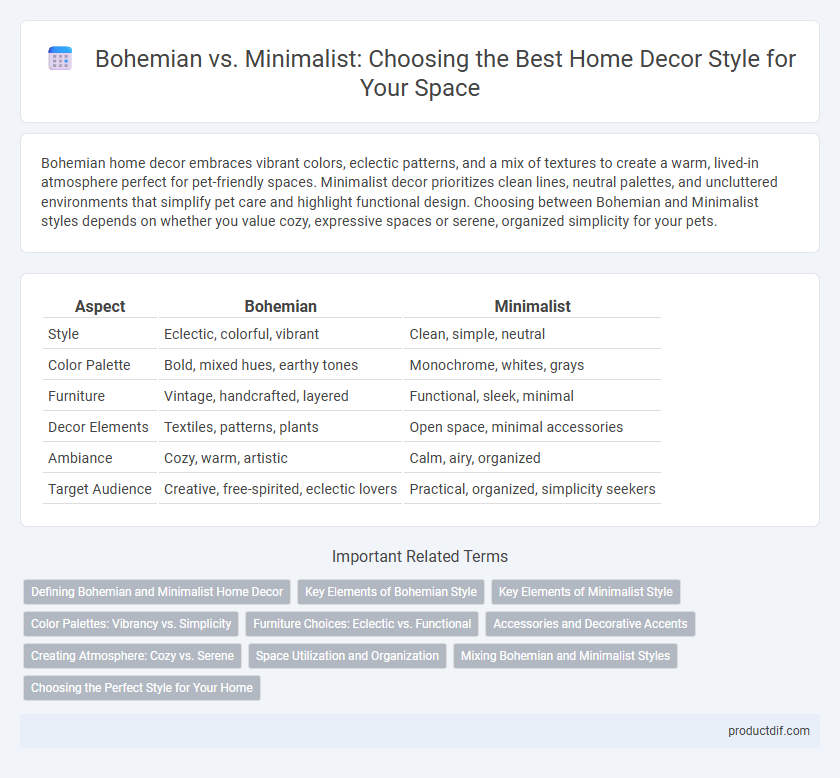Bohemian home decor embraces vibrant colors, eclectic patterns, and a mix of textures to create a warm, lived-in atmosphere perfect for pet-friendly spaces. Minimalist decor prioritizes clean lines, neutral palettes, and uncluttered environments that simplify pet care and highlight functional design. Choosing between Bohemian and Minimalist styles depends on whether you value cozy, expressive spaces or serene, organized simplicity for your pets.
Table of Comparison
| Aspect | Bohemian | Minimalist |
|---|---|---|
| Style | Eclectic, colorful, vibrant | Clean, simple, neutral |
| Color Palette | Bold, mixed hues, earthy tones | Monochrome, whites, grays |
| Furniture | Vintage, handcrafted, layered | Functional, sleek, minimal |
| Decor Elements | Textiles, patterns, plants | Open space, minimal accessories |
| Ambiance | Cozy, warm, artistic | Calm, airy, organized |
| Target Audience | Creative, free-spirited, eclectic lovers | Practical, organized, simplicity seekers |
Defining Bohemian and Minimalist Home Decor
Bohemian home decor is characterized by its vibrant colors, eclectic patterns, and an abundance of textures that create a relaxed, artistic atmosphere inspired by global influences. Minimalist home decor emphasizes simplicity, clean lines, and a neutral color palette to foster a clutter-free, calming environment focused on functionality. Both styles serve distinct aesthetic purposes, with Bohemian promoting creative expression and Minimalism prioritizing intentional living.
Key Elements of Bohemian Style
Bohemian style in home decor is characterized by vibrant colors, eclectic patterns, and a mix of textures that create a free-spirited, artistic ambiance. Key elements include layered textiles such as rugs and throw pillows, natural materials like wicker and rattan furniture, and an abundance of plants to enhance the organic, boho vibe. This style emphasizes individuality through curated collections of global-inspired accessories and handcrafted items, contrasting sharply with the clean lines and simplicity of minimalist design.
Key Elements of Minimalist Style
Minimalist home decor emphasizes clean lines, neutral color palettes, and uncluttered spaces to create a sense of calm and order. Key elements include functional furniture with simple shapes, minimal decorative accessories, and an emphasis on natural light to enhance the openness of the room. This style prioritizes quality over quantity, focusing on essential pieces that combine aesthetics and practicality.
Color Palettes: Vibrancy vs. Simplicity
Bohemian color palettes embrace vibrant hues like deep reds, rich oranges, and jewel tones, creating a lively and eclectic atmosphere. Minimalist design favors simplicity with neutral colors such as whites, grays, and soft beiges, promoting calm and spaciousness. The contrast between Bohemian vibrancy and Minimalist restraint defines their unique visual identities in home decor.
Furniture Choices: Eclectic vs. Functional
Bohemian furniture choices emphasize eclectic and vibrant pieces, often featuring handcrafted, vintage, and globally inspired designs that create a personalized and artistic space. Minimalist furniture prioritizes functionality and simplicity, with clean lines, neutral colors, and multipurpose items that maximize space and reduce visual clutter. The Bohemian style celebrates individuality through diverse textures and patterns, whereas Minimalism focuses on streamlined practicality and efficient use of furniture.
Accessories and Decorative Accents
Bohemian home decor features eclectic accessories such as vibrant tapestries, macrame wall hangings, and an assortment of colorful cushions that create a warm, layered look. Minimalist decor emphasizes sleek, functional decorative accents like geometric vases, monochrome artworks, and simple, unadorned lighting to maintain a clean, uncluttered space. The choice between Bohemian and Minimalist accessories significantly influences the atmosphere, from cozy and artistic to serene and orderly.
Creating Atmosphere: Cozy vs. Serene
Bohemian home decor creates a cozy atmosphere through layered textures, rich colors, and eclectic patterns that invite warmth and personal expression. Minimalist design fosters a serene environment by emphasizing simplicity, clean lines, and neutral palettes that reduce visual clutter and promote tranquility. Both styles prioritize ambiance but achieve it through contrasting elements--Bohemian's inviting warmth versus Minimalist's calm restraint.
Space Utilization and Organization
Bohemian home decor maximizes space utilization through layered textures, vibrant patterns, and eclectic furnishings that create a cozy, personalized environment with visible storage solutions like open shelves and woven baskets. Minimalist design emphasizes clean lines, decluttered spaces, and multifunctional furniture to optimize organization and maintain an airy, spacious feel by reducing material excess and focusing on essential items. Efficient space utilization in these styles reflects a balance between creative expression in Bohemian interiors and functional simplicity in Minimalist homes.
Mixing Bohemian and Minimalist Styles
Mixing Bohemian and Minimalist styles in home decor creates a balanced aesthetic that combines Bohemian's eclectic patterns and textures with Minimalist's clean lines and neutral palettes. Incorporate natural elements such as woven rugs, rattan furniture, and houseplants alongside sleek, simple furnishings to achieve a harmonious look. This fusion emphasizes curated, meaningful decor while maintaining an uncluttered and serene environment.
Choosing the Perfect Style for Your Home
Bohemian style embraces vibrant colors, eclectic patterns, and an abundance of textures, creating a cozy, personalized, and artistic atmosphere that reflects individuality. Minimalist decor prioritizes simplicity, clean lines, neutral palettes, and clutter-free spaces to foster tranquility and functionality. Selecting the perfect style depends on your preference for either expressive creativity with layered aesthetics or streamlined elegance and practicality.
Bohemian vs Minimalist Infographic

 productdif.com
productdif.com